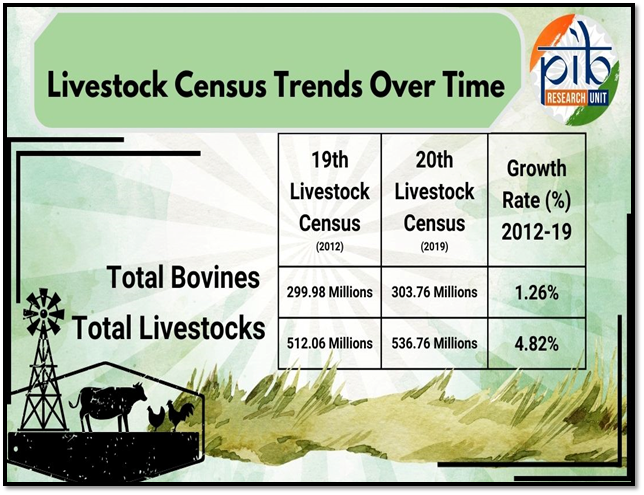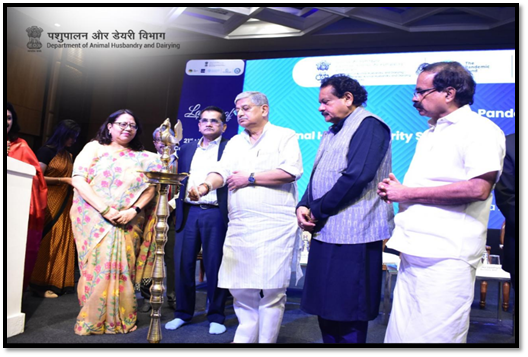Livestock Census: A Key Tool for Empowering Farmers and Boosting Rural Prosperity
Introduction
India’s rich and diverse livestock resources play a crucial role in the economy, supporting millions of livelihoods. To foster growth and ensure the welfare of this sector, it is vital to monitor livestock trends closely. The Livestock Census, conducted every five years, provides essential data on livestock numbers, distribution, and composition, guiding policymakers in addressing challenges and improving sustainability. This comprehensive survey serves as a critical touchstone, not only highlighting the current state of the livestock sector but also setting the stage for future planning and development. The insights gained from the Livestock Census are invaluable for driving informed decision-making and fostering sustainable practices across the industry.
Livestock Census and Integrated Sample Survey (Lc&Iss)[1]
The Animal Husbandry Statistics (AHS) Division is responsible for generating crucial statistics related to animal husbandry through the “Livestock Census and Integrated Sample Survey” scheme. This initiative, carried out by the Department of Animal Husbandry and Dairying in collaboration with State Animal Husbandry Departments, plays a vital role in collecting comprehensive data on livestock demographics and trends.
Key Mandates:
- Quinquennial Livestock Census (LC): Conducted every five years since 1919, the Livestock Census aims to provide a comprehensive count of livestock and poultry. The 20th census notably utilized tablet computers for data collection. Recently, the announcement for the 21st Livestock Census was made.
- Annual Integrated Sample Survey (ISS): Estimates production of milk, meat, egg, and wool through a survey covering 36 States/UTs. The survey period is from March to February, divided into three seasons. Uses Computer Assisted Personal Interviewing (CAPI) via the “eLISS” software.
- Publications:
- All India Livestock Report: Provides livestock population details by species, use, sex, and age.
- Breed-wise Report: Offers detailed livestock data based on the latest census.
- Basic Animal Husbandry Statistics: Annual publication releasing production estimates for key livestock products.
Importance of Livestock Census
India’s livestock and poultry resources are vast and play a crucial role in enhancing the socio-economic well-being of rural communities. The country is home to approximately 303.76 million bovines, including cattle, buffalo, mithun, and yak, along with 74.26 million sheep, 148.88 million goats, 9.06 million pigs, and about 851.81 million poultry, according to the 20th Livestock Census. These livestock resources are essential not only for providing nutrition and livelihood opportunities but also for driving rural economic growth and supporting sustainable agricultural practices across the nation.[2]
Growth in the Livestock Sector
Provisional estimates from the Ministry of Statistics and Programme Implementation (MoSPI) released on 31st May 2024 reveal that the Gross Value Added (GVA) from the livestock sector reached approximately ₹13,55,460 crores at current prices in the 2022-23 financial year, representing about 30.23% of the GVA for the Agricultural and Allied Sectors. When adjusted to constant 2011-12 prices, the GVA stood at around ₹6,90,268 crores, reflecting a growth rate of 5.02% compared to the previous year. Additionally, milk production during 2021-22 and 2022-23 was recorded 222.07 million tonnes and 230.58 million tonnes respectively, Depicting, an annual growth of 3.83%. This showcases the sector’s capacity to meet rising consumer needs while enhancing its contribution to rural livelihoods and the broader economy.[3]

21st Livestock Census [4]
Union Minister Shri Rajiv Ranjan Singh announced 21st Livestock Census on 25th October in New Delhi. The event marked a significant step forward with the introduction of digital advancements aimed at enhancing the accuracy and efficiency of data collection. Among these innovations is a new mobile application for real-time data gathering, which will be complemented by a web-based dashboard that allows for seamless tracking and timely insights. Additionally, offline data capture capabilities have been included to ensure thorough enumeration, even in remote and rural areas.

Extensive preparations were undertaken to ensure the smooth execution of the census, including the training of over 1 lakh field personnel through regional and state-level programs, as well as the development of a robust digital infrastructure to support the data collection process. Covering more than 30 crore households across all States and Union Territories, the census aims to capture the full diversity of India’s livestock practices, including those of nomadic communities and pastoralists.
The census will focus on important areas such as gender roles in livestock rearing, offering a deeper understanding of women’s contributions to the sector. It will also emphasize breed management, utilizing image-based technology to accurately identify livestock breeds, while prioritizing critical aspects like animal health, productivity, and disease control to address the sector’s key challenges.
Schemes for Betterment of Livestock[5]
India’s livestock sector has seen significant improvements through various schemes aimed at enhancing productivity, health, and infrastructure. Here’s a brief overview of some key initiatives:
- Rashtriya Gokul Mission (RGM): Launched in 2014, RGM focuses on the development and conservation of indigenous bovine breeds to improve milk production and make dairy farming profitable for rural farmers, especially women. The program emphasizes genetic improvement through artificial insemination, IVF, and genomic selection.
- National Livestock Mission (NLM): Launched in 2014-15, NLM aims at employment generation, entrepreneurship development, and increased production of meat, eggs, milk, and wool. It supports both forward and backward linkages in the livestock sector, enabling the integration of the unorganized sector with formal markets.
- Livestock Health & Disease Control (LH&DC): This scheme aims to improve animal health by implementing vaccination programs and disease surveillance to prevent and eventually eradicate diseases. The funding pattern includes 100% central assistance for some programs and shared funding between the central and state governments for others.
- National Programme for Dairy Development (NPDD): NPDD aims to enhance milk quality and increase organized milk procurement, with nationwide implementation of infrastructure for quality testing and chilling. Component B, a JICA-supported pilot project, focuses on dairy infrastructure and market linkages in Uttar Pradesh and Bihar.
- National Animal Disease Control Programme (NADCP): Launched in 2019, NADCP aims to control Foot & Mouth Disease (FMD) and Brucellosis by vaccinating livestock. It targets 100% vaccination of cattle, buffalo, sheep, goat, and pig populations for FMD and female bovine calves for Brucellosis.
- Dairy Processing & Infrastructure Development Fund (DIDF): Initiated in 2017-18, DIDF provides subsidized loans to upgrade processing and chilling infrastructure. The scheme aims to modernize milk procurement systems, with funding from NABARD, government contributions, and end borrowers.
- Animal Husbandry Infrastructure Development Fund (AHIDF): Part of the Atma Nirbhar Bharat initiative, AHIDF promotes private sector investment in dairy, meat processing, animal feed production, breed improvement, and veterinary vaccine facilities, aiming to boost the sector’s growth.
- Supporting Dairy Cooperatives & Farmer Producer Organizations (SDCFPO): This scheme provides working capital loans to dairy cooperatives, ensuring sustained operations and market access for milk producers.
These initiatives collectively aim to improve livestock productivity, strengthen infrastructure, and support the socio-economic upliftment of livestock farmers across the country.
Conclusion
The 21st Livestock Census will play a pivotal role in shaping livestock-centered schemes and initiatives, such as the National Gokul Mission, Livestock Health & Disease Control (LH&DC), and the National Programme for Dairy Development (NPDD). By providing comprehensive and updated data, the census will help identify the needs and opportunities in the sector, enabling the government to fine-tune these programs for greater impact. The insights gathered will not only strengthen existing initiatives but also pave the way for new strategies aimed at enhancing livestock productivity, improving animal health, and boosting rural incomes. Ultimately, this will contribute to the sustainable growth of the livestock sector, benefiting millions of households and driving overall economic development.

